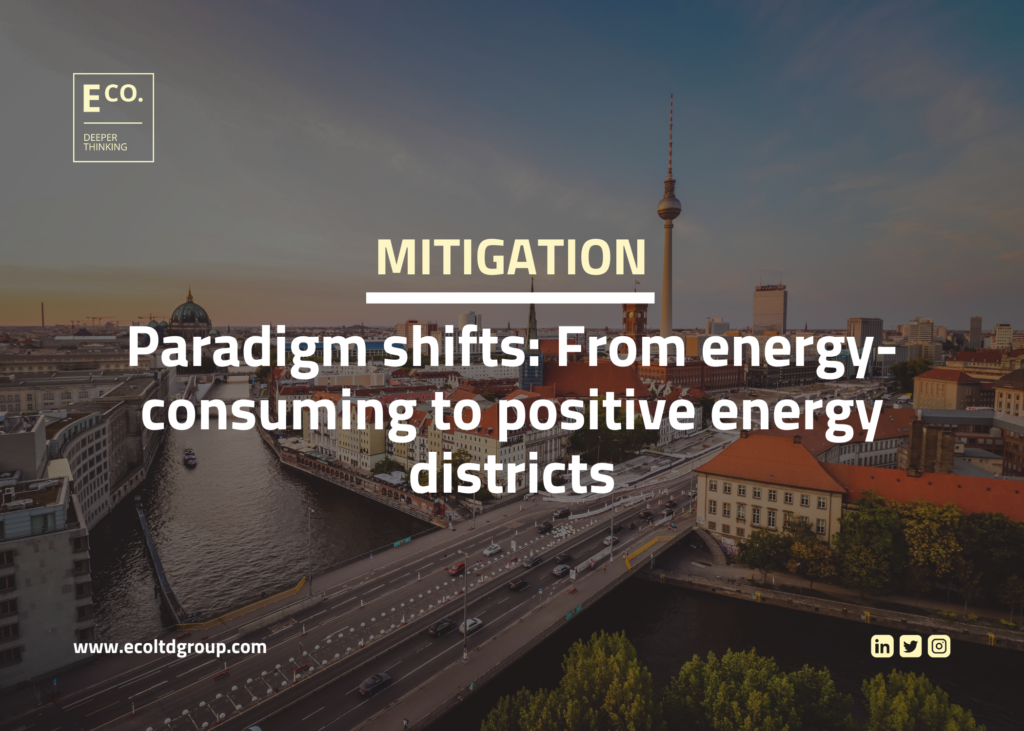Paradigm shifts: From energy-consuming to positive energy districts
10 October 2023, Category: All insights, News, Tags: climate finance, energy, positive energy districts

From traditional ‘low’ and ‘passive’ to ‘zero’ and ‘positive’, various energy concepts are being implemented in construction sectors across the globe, although the pace of adoption varies. Initially, these concepts captivated the scientific community, energy professionals, and enthusiasts alike.
Now, the movement from energy-consuming districts to positive energy districts represents a fundamental paradigm shift, driven by a blend of policy and technological advancements, increased awareness, and community engagement, as well as a shared commitment towards a sustainable future. Positive energy districts align with the imperative global energy and climate agendas. In this article, we will be answering three key questions:
- What are positive energy districts?
- Who is taking the lead on positive energy districts?
- What are examples of positive energy districts?
What are positive energy districts?
Simply put, positive energy districts focus on creating a balance between energy demand and supply while minimising environmental impact. They often incorporate the following features:
- Renewable Energy Generation: They utilise renewable energy sources like solar, wind, geothermal, and sometimes biomass to produce clean energy on-site.
- Energy Efficiency: Buildings within these districts are designed with high energy efficiency standards, utilising insulation, efficient appliances, and smart energy management systems.
- Smart Infrastructure: Advanced technologies, such as smart grids and energy storage systems, are implemented to optimise energy flow and distribution.
- Mixed Land Use: These districts often incorporate a mix of residential, commercial, and industrial spaces to reduce the need for commuting and support local economies.
- Sustainable Mobility: Emphasis is placed on public transportation, cycling lanes, pedestrian-friendly spaces, and electric vehicle charging infrastructure.
- Green Spaces: Parks, green roofs, and urban agriculture are integrated to improve air quality, provide recreational areas, and support biodiversity.
- Circular Economy: Waste management and recycling systems are integrated to reduce waste and promote resource efficiency.
While the concept of positive energy districts is being refined, several formal definitions have emerged. The EU’s PED reference framework definition is as follows:
“Positive Energy Districts are energy-efficient and energy-flexible urban areas or groups of connected buildings which produce net zero greenhouse gas emissions and actively manage an annual local or regional surplus production of renewable energy. They require integration of different systems and infrastructures and interaction between buildings, the users and the regional energy, mobility and ICT systems, while securing the energy supply and a good life for all in line with social, economic and environmental sustainability.”[1]
The IEA EBC Annex 83 on Positive Energy Districts is still working on developing internationally viable definition of PED, but provides the following description in the meantime:
“The basic principle of Positive Energy Districts (PEDs) is to create an area within the city boundaries, capable of generating more energy than consumed and agile/flexible enough to respond to the variation of the energy market because a PED should not only aim to achieving an annual surplus of net energy. Rather, it should also support minimizing the impact on the connected centralized energy networks by offering options for increasing onsite load-matching and self-consumption, technologies for short and long term storages, and providing energy flexibility with smart control.”[2]
Who is taking the lead on positive energy districts?
In this transition, certain regions have taken the lead. Notably, the European Union (EU) stands out as a frontrunner. To accelerate efforts and achieve ambitious sustainability goals, the EU has established the Working Group for Positive Energy Districts, aiming to deploy and replicate 100 ‘Positive Energy Districts’ by 2025. This initiative is instrumental in realising climate-neutral cities and fostering sustainable, inclusive urban neighbourhoods. Additionally, the EU has crafted an implementation plan, SET-Plan ACTION n°3.2 [3], to position Europe as a global role model in innovative solutions for the planning, deployment, and replication of Positive Energy Districts.
At the international level, the International Energy Agency (IEA) has been a pivotal player. In 2019, the IEA initiated the technology collaboration program (TCPs) on energy in buildings and communities, specifically Annex 83 on Positive Energy Districts (PEDs). This program serves as the main platform for global scientific debates and research in this domain.
What are the examples of positive energy districts?
Vauban, Freiburg, Germany [4]:
Vauban is a district in Freiburg, a city in southwestern Germany known for its long-standing commitment to sustainable urban development. Vauban’s development began in the 1990s, intending to create a positive energy district, focusing on energy efficiency, renewable energy production and sustainable transport:
- The district incorporates energy-efficient building designs, rooftop solar panels, a decentralised energy system, and an efficient municipal biomass and natural gas cogeneration plant. Buildings are highly insulated to minimise energy demand, and solar panels provide a significant portion of the district’s energy needs.
- Vauban also emphasises sustainable mobility, with an extensive network of pedestrian and bicycle paths, efficient public transportation, and limited car access to reduce emissions and promote a more eco-friendly lifestyle.
ReGen Village, Almere, Netherlands [5]:
ReGen Village represents an emerging model of comprehensive sustainable living, combining various elements to form a community that is both self-sustaining and regenerative. The project incorporates a range of sustainable features to create a positive impact on both energy and food production. Some key aspects of the ReGen Village project include:
- The community utilises a mix of renewable energy sources, including solar panels and wind turbines, to generate electricity. These sources contribute to the overall energy needs of the village. The village employs smart grid technology to efficiently manage and distribute energy. This includes systems for monitoring energy usage, optimizing energy distribution, and incorporating energy storage solutions.
- The houses in ReGen Village are designed with energy efficiency in mind. They incorporate modern construction techniques, insulation, and energy-efficient appliances to minimise energy consumption.
- The project incorporates vertical farming systems to produce food locally. This not only reduces the ecological footprint associated with food transportation but also contributes to a more sustainable and resilient food supply for the community.
- ReGen Village implements waste-to-energy systems, converting organic waste into biogas or other forms of energy. This helps in minimizing waste while simultaneously generating additional renewable energy.
- The village employs water recycling and conservation measures to minimise water usage and ensure a sustainable water supply for the community.
Please note that the status and details of these projects may have evolved since our updates. If you are interested in seeing more inspiring examples of positive energy neighbourhoods, set in different contexts and climates across the globe, check the following booklets:
- Urban Europe – Europe Towards Positive Energy Districts
- Cities4PEDS – From 7 case interviews to recurring strategies and PED relevant aspects
Keep up-to-date with climate finance know-how
Looking for insight into climate finance? Look no further
Get in touch with our climate finance consultants to discuss a project you’re working on and create successful, fit-for-purpose projects, now and in the future. Email us at: amy@ecoltdgroup.com or find us at the following:
Twitter: @ecoltdnews
LinkedIn: E Co.
Instagram: @ecoltdnews
References
- https://jpi-urbaneurope.eu/ped/#:~:text=%E2%80%9CPositive%20Energy%20Districts%20are%20energy,surplus%20production%20of%20renewable%20energy.
- https://annex83.iea-ebc.org/
- https://jpi-urbaneurope.eu/wp-content/uploads/2021/10/setplan_smartcities_implementationplan-2.pdf
- https://www.smartcitiesdive.com/ex/sustainablecitiescollective/words-most-successful-model-sustainable-urban-development/229316/
- https://www.themayor.eu/en/a/view/re-gen-village-the-world-s-first-self-sustaining-eco-village-1276

Join the conversation by posting a comment below. You can either use your social account, by clicking on the corresponding icons or simply fill in the form below. All comments are moderated.